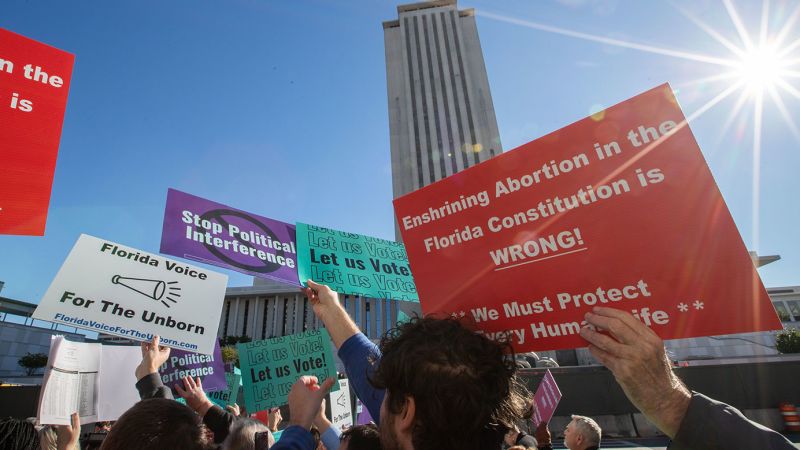Report: Significant Impact of Florida’s Six-Week Abortion Ban on State and National Trends
Florida’s recent six-week abortion ban has reportedly resulted in a notable decline in the number of abortions performed in the state and has influenced national abortion trends, according to a new report from the Guttmacher Institute.
The organization, which is dedicated to research and policy regarding sexual and reproductive health and advocates for abortion rights, determined that monthly abortions in Florida plummeted by more than 30% following the enactment of the ban in May. The report indicates that the average number of abortions fell to approximately 5,400 per month during May and June, a sharp decrease from over 8,000 monthly in the first quarter of the year.
Nationally, the average monthly abortion rate declined by 7%, which translates to roughly 7,000 fewer abortions across the country. Florida’s decrease significantly contributed to this national decline, accounting for more than one-third of the overall reduction.
Experts note that while there are typically seasonal fertility patterns and some month-to-month variations in abortion rates, the alterations in Florida’s data were pronounced. Other states that have not implemented total abortion bans experienced only minor changes, with a 2% decrease in May and a 9% drop in June.
The report explains that the stricter regulations in Florida were anticipated to reverberate throughout the state and its vicinity. Before the ban was imposed, Florida was responsible for more than 10% of the nation’s abortions, having become a critical access point for abortion services in the South since the U.S. Supreme Court’s Dobbs decision rescinded federal abortion rights in 2022.
Approximately 9,000 individuals traveled to Florida from out of state for abortion services in 2023, according to Guttmacher’s estimates, many hailing from states with even stricter abortion restrictions, such as Texas, Louisiana, Mississippi, Alabama, and Georgia.
Despite the recent downturn in Florida, Guttmacher’s estimates indicate an increase in the total number of abortions in the U.S. during the first half of 2024 compared with the same period in 2023, and figures from last year represented the highest rates seen in over a decade.
Isaac Maddow-Zimet, a data scientist with the Guttmacher Institute and contributor to the report, stated that the abortion landscape is evolving rapidly within the U.S., leaving uncertainty about future patterns as the year progresses. He emphasized, “Many organizations, institutions, and people have sprung up to really support the needs of abortion seekers in the US… The scale of it is really clear in the ways in which abortion numbers have gone up in states without bans. There has been much more funding available and other modes of care, like telehealth, that really speaks to the ways in which people may be able to access care now in those states that may not have been able to before. At the same time, of course, access has gotten tremendously worse in banned states.”
The analysis also revealed that prior to the implementation of the ban, Florida observed a significant spike in the number of abortions—over 20% higher than the quarterly average—in April. The report notes, “Providers and patients went to great lengths to provide and access care, respectively, before the law went into effect.”
Maddow-Zimet cautioned that although recent influxes of funding have helped mitigate the barriers posed by the new ban, as well as longstanding cost issues post-Dobbs, this support may not be sustainable.
Looking ahead, Florida is one of at least ten states where voters will have the opportunity to decide on the future of abortion access in elections this November. However, ongoing adjustments to abortion policies since the Dobbs ruling have left many women across the U.S. confused.
Maddow-Zimet highlighted the urgency of access, noting, “When people need abortions, it’s within a very short time period. And the pace of legal change can be very slow. Ballot measures could potentially increase access but would come too late for people who are pregnant right now.”
In light of the absence of federal protections like Roe v. Wade, more women are reportedly opting for permanent contraception to eliminate the possibility of pregnancy. Research published in the medical journal JAMA reveals that the number of women choosing to tie or remove their fallopian tubes increased after the Dobbs decision, particularly in states with abortion bans.
A study that analyzed millions of medical records through December 2022 indicated that tubal sterilization use surged nationwide right after the Supreme Court ruling, maintaining a 3% monthly increase in states that enforce abortion bans.
Demographer Amanda Jean Stevenson from the University of Colorado-Boulder, who was not involved in the Guttmacher report, remarked on the potential implications of increased permanent contraception use on abortion trends, stressing that access barriers—whether medical, social, or economic—overlap with those affecting abortion care. “Being able to access wanted reproductive healthcare is subject to similar barriers across the board,” she noted, emphasizing that those who face barriers to abortion are likely to experience similar challenges in accessing sterilization.












